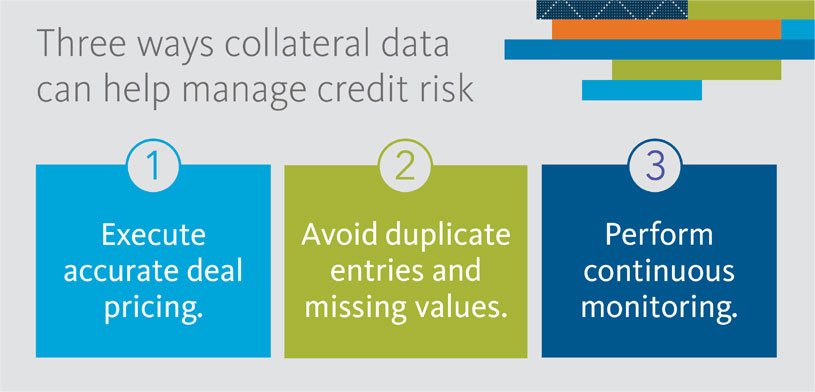Access the latest news, analysis and trends impacting your business.
Explore our insights by topic:
Additional Broadridge resource:
View our Contact Us page for additional information.
Our representatives and specialists are ready with the solutions you need to advance your business.
Want to speak with a sales representative?
| Table Heading | |
|---|---|
| +1 800 353 0103 | North America |
| +442075513000 | EMEA |
| +65 6438 1144 | APAC |
Your sales rep submission has been received. One of our sales representatives will contact you soon.
Want to speak with a sales representative?
| Table Heading | |
|---|---|
| +1 800 353 0103 | North America |
| +442075513000 | EMEA |
| +65 6438 1144 | APAC |
Valuations and other loan metrics are variable. Multiple loans tied to a single asset can create duplicate entries and missing values. It’s hard to track effectively—and the stakes couldn’t be higher. Inconsistent or incomplete collateral data can cause significant credit risk for the bank.
In principle, handling collateral isn’t especially complex. When there is one security for one loan, it’s easy to perform multiple checks prior to releasing collateral. But what happens when you have volumes of loans across several lines of business? Collateral becomes much harder to track and manage.
Most modern banks contain an extensive infrastructure of fragmented credit and collateral systems. Each business line might use its own collateral tracking system, creating an impossible situation that prevents banks from gaining a clear view of their banking book. In the worst case, banks may inadvertently release collateral, leaving loans unsecured and exposing the bank to substantial credit and reputational risk.
It’s no surprise that more banks are turning toward a comprehensive banking book collateral management solution. Here are three ways a golden view of collateral data can help you effectively manage credit risk.

A digital approach helps to maximize accuracy and ensure complete visibility into complex collateral arrangements
#1 Execute accurate deal pricing.
Deals are traditionally priced based on the borrower’s ability to repay, the loan-to-value ratio and the wholesale cost of credit. Today most credit risk-driven banks are moving toward including loss given default (LGD) as a key pricing parameter.
By accurately tracking the recovery value of an encumbered asset, banks can create a longitudinal review of recovery values for specific asset types. From there, banks can feed these values into their LGD parameters and pricing models to reflect the true risk in case of default. The result: better deal-specific rates, enabling better credit risk management and market competitiveness.
#2 Avoid duplicate entries and missing values.
Duplicate records and missing values create risk for the bank. Consider how much labor is required to resolve data inaccuracies and to fix gaps. Similarly, failure to identify collateral duplication is especially problematic in complex loan portfolios where cross-collateralization requires careful ongoing scrutiny. By bringing your entire credit collateral onto a single platform, it’s much easier to check new inputs against existing records to eliminate duplicates and gaps.
#3 Perform continuous monitoring.
Manual operations and multiple, disparate systems make it difficult to track, update and maintain collateral valuations and liens. Bringing it all together on an enterprise-wide, consolidated collateral platform can make the difference. Banking book collateral management solutions facilitate digital submission, making it easier to trace lien registrations, UCC filings and continuations. Digital processes streamline loan payoff and collateral release reviews. Automated workflows make it easier to monitor for accurate insurance coverage, flood zone coverage and environmental reports.
Monetize collateral across your entire lending lifecycle.
Credit risk exposure continues to put pressure on banking profit. Let Broadridge help. COLLATE is the only platform that puts a golden view of loan collateral at your fingertips. Now you can map your entire credit landscape to reveal credit risk exposures and execute detailed credit governance in the banking book. Track and trace collateral perfection, relationships and lineage from the bottom up—for even the most complex loans.
For more, contact your Broadridge Account Representative today, or visit broadridge.com/COLLATE.
Luke Nestor has been in the Financial Services technology business for over thirty years. An expert in credit and loan systems, Luke founded Rockall to create banking book collateral management products that deliver value both operationally and strategically. Over his career, Luke has designed and built retail banking systems across multiple divisions.
Welcome back, {firstName lastName}.
Not {firstName}? Clear the form.